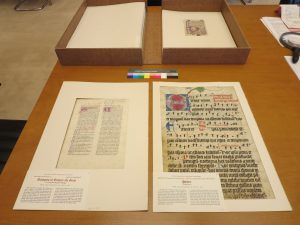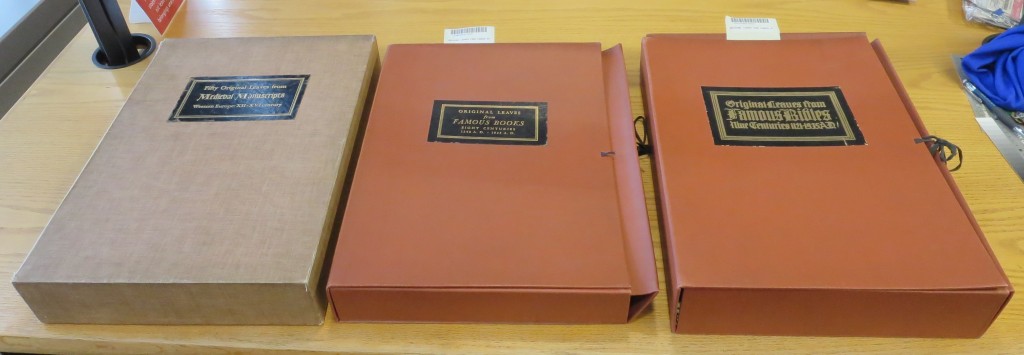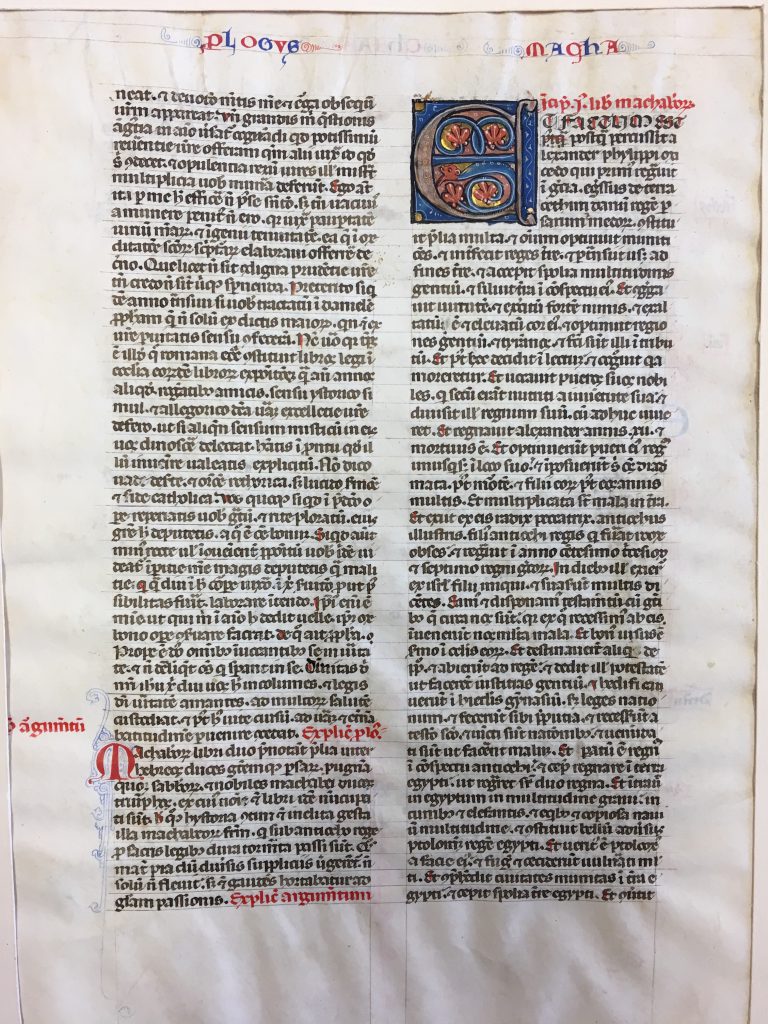Mildred Budny
(Research Group on Manuscript Evidence)
“The ‘Diaspora’ and Retrievals of Otto Ege Manuscripts:
Reflections on Methodologies of Discovery“
Abstract of Paper
Intended To be presented at the 55th International Congress on Medieval Studies
(Kalamazoo, 2020)
[CONGRESS CANCELLED]
Session on
“The Legacy of Otto Ege”
Sponsored by the Beinecke Rare Books & Manuscript Library
Organized by Elizabeth K. Hebbard
2020 Congress Program Archived / 2020 Congress Program
[Update:
Presented at the 56th Congress
(Kalamazoo, 2021), with further updates.
2021 Congress Program, Session 79 (page 29)]
[Published on 1 May 2020, with updates]
*****
Abstract (Updated)

Beinecke Rare Book and Manuscript Library, Otto Ege Collection. The Ege Family Portfolio, Leaves 41 and 42 and the box. Photograph by Mildred Budny.
Admiring the opportunities presented by the Otto Ege Manuscript Collection at The Beinecke Rare Book & Manuscript Library, and the advances in knowledge about the nature and impact of this collection, I propose to offer reflections drawing upon my ongoing research on a varied group of manuscripts dispersed by Otto Ege. They first came to my attention over a series of years, as individual subjects of conservation, photography, and research, in the form of one, two, or a few leaves in private and institutional collections. Results — or preliminary or interim results — of this research are presented in the RGME blog on Manuscript Studies (see its Contents List).
So far, my work has focused upon Ege Manuscripts 8, 14, 19, 41, 51, 56, 61, and 214, with publications and updates as more discoveries emerge. In Latin, Dutch, or Armenian, the manuscripts comprise respectively the Wilton Processional, a magnificent Lectern Bible, a portable Bible from Italy, a copy of the Dialogues of Gregory the Great and others’ texts, a Pocket Vulgate Bible, an Armenian Biblical manuscript, Aristotle’s Nichomachian Ethics with Commentary, and a Dutch prayerbook. In recent years, for example with Alison Altstatt’s exemplary work on Ege MS 8 as a whole, it has been easy to concentrate on others in this group.
The quest to identify the leaves, their former manuscripts, other leaves from those manuscripts, and their patterns of dispersal has opened an invigorating voyage of discovery: dedicated, sometimes serendipitous, occasionally frustrating, and richly cumulative. Important components for that voyage include the generous access allowed by many collections, both private and public, and the exchange of information fostered by many researchers of this rapidly growing field of Ege Manuscript Studies.
My own work has progressed through detailed examination not only of these manuscripts, insofar as they can be reconstructed, but also of their various forms of dispersal, given their ‘find-places’. Those forms range from separate leaves, mounted or unmounted, to no less than three of Ege’s Portfolios, in their several significant ‘flavors’. Now dispersed in multiple collections, these Portfolios or their remnants present
Fifty Original Leaves from Medieval Manuscripts, Western Europe: MSS 8, 14, 19, and 41
Original Leaves from Famous Bibles, Nine Centuries
in 2 Series (“A” with 37 Leaves and “B” with 60 Leaves): MSS 56 and 61
Original Leaves from Famous Books
in 2 Series (“Eight Centuries” with 25 Leaves and “Nine Centuries” with 40 Leaves): MS 51

Three Ege Portfolios. From the Collection of The Public Library of Cincinnati and Hamilton County. Photograph by Mildred Budny.
Examining each individual copy of these Portfolios, as I might have the chance to encounter them directly, reveals a growing body of evidence regarding their changing methods of assembly, the presentation of individual leaves within (not infrequently) varied approaches to the mounts, and other features. Those elements, beyond the manuscript leaves themselves, can sometimes provide clues otherwise unrecorded, extant, or unavailable, concerning the context and transmission of the originals.
Direct experience with a varied group of dispersed Ege manuscripts and their shared or idiosyncratic challenges gives rise to observations and reflections about some methodological challenges and opportunities inherent in Ege Manuscript Studies. I survey selected cases involving the material evidence of the manuscripts, their former and current settings, testimony from their library history, and contextual studies relating to the manuscripts themselves and to Ege Manuscripts overall.
*****
Addendum (1 May 2020)
Although the cancellation of the Congress prevented the opportunity to present this paper in person at the session sponsored by The Beinecke, I have been able to publish a detailed report of some of the results which the paper was intended to survey and newly to reveal. This report centers upon a new leaf from Ege Manuscript 19, with observations on some of Ege’s “workshop practices” in mounting and distributing his manuscript leaves, both in Portfolios and in other forms.

J. S. Wagner Collection. Leaf from Ege Manuscript 19, verso.
*****
Activities sponsored and co-sponsored by the Research Group on Manuscript Evidence which were planned for the 2020 Congress are announced, along with their Abstracts of Papers, in 2020 International Congress on Medieval Studies Program Announced .
It is uncertain to what extent the Sessions intended for the 2020 Congress will be rescheduled. Meanwhile, this and the other Abstracts serve as indicators of what subjects, approaches, and results were to be presented. For updates, Watch This Space.
[Update on 18 June 2020. Now see Some Leaves in Set 1 of Otto Ege’s FOL Portfolio.]
*****
